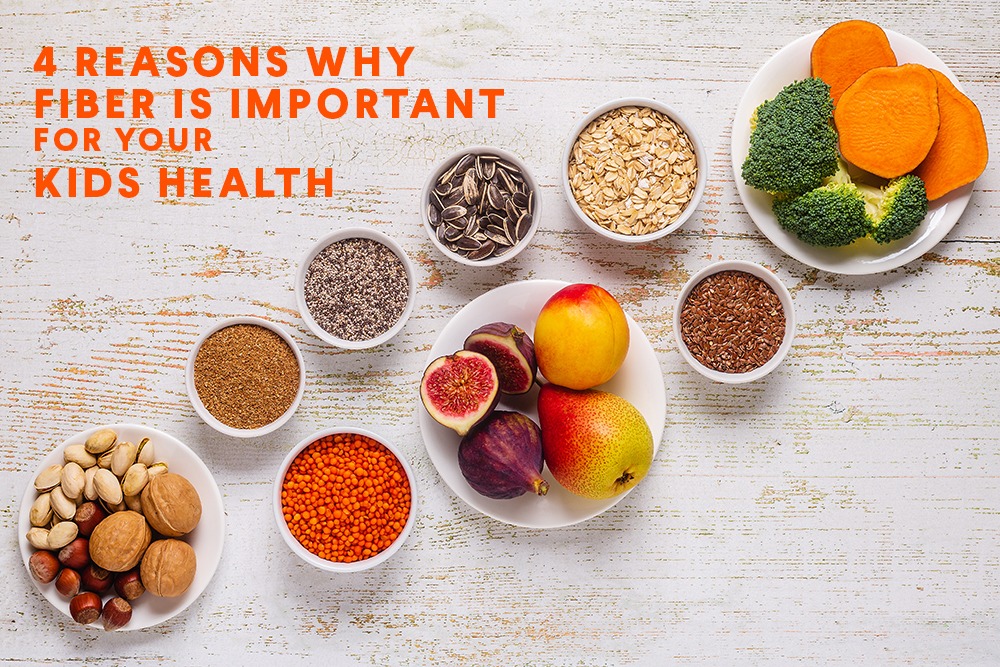
An important and often overlooked nutrient for maintaining your child’s health is fiber. In fact, the average fiber intake for children in America is less than half of the recommended amount, which can lead to a wide variety of health problems. You may be wondering why fiber is important for your child, what foods have the most fiber and how you can help you can include more fiber into your child’s daily food choices.
What is fiber?
Fiber is a complex carbohydrate that your body cannot digest. It is found in plant foods including whole grains, legumes, nuts, seeds, vegetables and fruits. There are two forms of fiber – soluble and insoluble. Soluble fiber dissolves in water and forms a gel when it moves through the digestive tract. Oats, beans, apples, and berries are an example of soluble fiber. Insoluble fiber, such as nuts and legumes, does not dissolve in water and helps move food through the digestive system.
Why is fiber important for your child’s health?
Fiber offers a wide variety of health benefits for children, including preventing constipation, staying full longer after eating meals and snacks, and supporting balanced blood sugar levels, which can help reduce behavioral issues, stabilize moods, increase energy, and improve concentration. Foods rich in fiber also contain important vitamins and minerals that may help reduce diseases such as heart disease, cancers, and obesity. Fiber has also been shown to reduce cholesterol levels, help with weight loss, supports the immune system, and improve gut health.
How does fiber affect digestion?
Soluble fiber slows down digestion, while insoluble fiber speeds up digestion and adds bulk to the stool. If your child is constipated, a combination of both soluble and insoluble fiber helps to normalize bowel function. For diarrhea, soluble constipation helps add bulk to the stool and absorbs water.
A more specific example of how fiber affects digestion includes eating whole fruits compared to processed fruit juices or fruit snacks, which lack fiber and are high in fructose and high-fructose corn syrup (HFCS). Digestion of fiber in whole fruits helps slow down the release of fructose so that blood sugar doesn’t rise and then crash quickly. This helps keep hunger and blood sugar in check, as well as more stable energy, moods, and sleep. Whole fruit (and vegetables) contain a prebiotic fiber called pectin, which promotes and anti-inflammatory gut ecosystem, feeds healthy gut bacteria and reduces the growth of harmful gut bacteria. On the other hand, HFCS, which is produced from corn starch, is sweeter, cheaper and more quickly absorbed in the body than unrefined sugar and has been linked to insulin resistance, obesity, type 2 diabetes, and high blood pressure. HFCS consumption can lead to increased appetite, blood sugar fluctuations, weight gain, and increased cholesterol.
How much fiber should my child eat every day?
The recommended dietary fiber intake for children and adults is 14 g/ 1000 kcal. When reading nutrition labels, you can determine if the food is an excellent source of fiber if it has 5 or more grams of fiber per serving and a good source has at least 3 grams of fiber per serving. A good rule of thumb is to help your kids eat at least 5 servings of fruits and vegetables each day. Also, make sure your child is getting plenty of hydration (aim for at least half of the child’s weight in fluid ounces of water per day) and that fiber intake is increased slowly, otherwise adding too much too quickly can cause some digestive upset such as gas, bloating, abdominal cramps, and constipation.
Here are some of our favorite fiber-rich foods to include in your cooking:
Whole grains: Steel cut oats, quinoa, amaranth, buckwheat, teff, millet, brown rice, wild rice, wheat.
Legumes: Kidney beans, navy beans, pinto beans, black beans, lima beans, lentils, chickpeas.
Nuts & Seeds: Chia seeds, flax seeds, pumpkin seeds, coconut, sesame seeds, almonds, pistachios, hazelnuts, pecans, macadamia nuts, sunflower seeds, Brazil nuts.
Vegetables: Cauliflower, broccoli, celery, carrots, asparagus, squash, parsley, Brussels sprouts, dark leafy greens (kale, collards, Swiss chard, mustard greens, etc).
Fruits: Apples, passion fruit, kiwi, persimmon, pomegranate, oranges, grapefruit, berries, tomatoes, bananas, guava, melons, avocado, peaches (make sure to keep edible peels on, as they’re a great source of fiber and nutrients).
Now that you understand how important fiber is in supporting your child’s health, including preventing constipation and diarrhea, stabilizing blood sugar, energy, moods, and much more, we hope you are excited to include more fiber-rich meals and snacks into your cooking routine.
Would you like some cooking inspiration?
Try some of our favorite fiber-packed recipes
(which are also a great source of vitamins and minerals to support healthy growth and development) including:
Coconut Flour Lemon Blueberry Muffins
Violet Blueberry Banana Smoothie
Stir Fried Brown Rice with Veggies
Roasted Garlicky Chickpea and Rice Bowls
Additional References:
https://www.hsph.harvard.edu/nutritionsource/carbohydrates/fiber/










